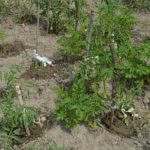Gardening enthusiasts are increasingly turning to natural methods for cultivating their plants, with a particular focus on vegetable gardens. As people become more conscious of the impact of synthetic fertilizers and chemicals on the environment, there is a growing interest in finding sustainable and eco-friendly alternatives. One such method gaining popularity is the use of wood ash as a beneficial additive for vegetable gardens.
As gardeners seek to maximize the health and productivity of their vegetables, questions about the effectiveness of using wood ash often arise. Is wood ash good for vegetable gardens? This article aims to provide answers to this query by exploring the benefits, composition, and application of wood ash in vegetable gardening.
Wood ash is formed when organic materials such as wood are burned completely. It contains a range of nutrients and minerals that can be beneficial for plant growth.
Understanding the composition and nutritional value of wood ash can help gardeners make informed decisions about its usage as a natural fertilizer or soil amendment in their vegetable gardens. Additionally, exploring how the alkalinity of wood ash alters soil pH levels and its effects on vegetable growth can shed light on whether it is a suitable addition for specific plants.
By delving into scientific studies and real-life success stories, this article will walk readers through various aspects related to using wood ash in vegetable gardens. From understanding its nutritional content to controlling pests and diseases naturally, gardeners can gain insights into how they can incorporate this natural resource into their gardening practices effectively and sustainably. So let’s dive into the world of wood ash and discover its potential benefits for your vegetable garden.
Composition and Nutritional Value of Wood Ash
Wood ash is a valuable additive for vegetable gardens due to its composition and high nutritional value. Understanding the components of wood ash can help gardeners make informed decisions about its use in their gardens.
Composition: Wood ash is obtained by burning wood, which leaves behind fine white or grayish powder. It is primarily composed of calcium carbonate (lime), along with smaller amounts of potassium, phosphorus, and other trace minerals. The exact composition of wood ash can vary depending on the type of wood burned and the temperature at which it was burned.
Nutritional Value: Wood ash contains several essential nutrients that are beneficial for vegetable plants. Calcium carbonate present in wood ash helps raise soil pH levels and neutralize acidic soils. Potassium promotes overall plant health, aids in photosynthesis, and improves plant disease resistance. Phosphorus is crucial for root development and flower/fruit production. Additionally, wood ash also contains trace amounts of micronutrients like magnesium, zinc, copper, and iron that are vital for various physiological processes in plants.
When used appropriately, the mineral content in wood ash can improve the fertility and structure of soil, leading to healthy plant growth. However, it’s important to note that excessive application of wood ash can disrupt the balance of nutrients in the soil and harm plants. Thus, moderation is key when using this natural fertilizer.
To maximize the benefits of wood ash in vegetable gardens:
- Conduct a soil test to determine existing nutrient levels and pH before adding wood ash.
- Apply small quantities initially to observe how plants respond.
- Incorporate wood ash into the soil during spring or fall to ensure thorough mixing.
- Avoid direct contact between fresh wood ash and plants to prevent potential leaf burn or damage.
While wood ash offers many nutritional benefits for vegetable gardens, it is crucial to strike a balance by considering other factors such as existing soil pH levels and nutrient requirements specific to different vegetables. With proper understanding and application, wood ash can be a valuable addition to achieving healthier and more productive vegetable gardens.
pH Level and Soil Alkalinity
Understanding the pH level and soil alkalinity is crucial when considering the effects of wood ash in vegetable gardens. The pH scale measures the acidity or alkalinity of the soil, with a value of 7 being neutral. Soils with a pH below 7 are considered acidic, while soils with a pH above 7 are alkaline. Most vegetables prefer slightly acidic soil, with a pH range between 6 and 7.
Wood ash, being highly alkaline, has the potential to raise the pH level of the soil when applied as an additive. This can be beneficial for certain plants that thrive in alkaline conditions, such as asparagus, cabbage, lima beans, and some varieties of tomatoes. However, it’s important to note that not all vegetables tolerate high levels of alkalinity well.
The effects of wood ash on soil alkalinity can have both positive and negative impacts on vegetable growth. On one hand, an increase in pH can help fight off certain diseases and pests that thrive in acidic environments. Furthermore, some nutrients like phosphorus become more available to plants in neutral or slightly alkaline soils. On the other hand, excessively alkaline soil can hinder nutrient absorption by plants and lead to deficiencies in essential elements like iron and manganese.
| Vegetables Benefiting from Wood Ash | pH Range Tolerance |
|---|---|
| Asparagus | 6-8 |
| Cabbage | 5.5-7.5 |
| Lima Beans | 5.8-6.8 |
| Tomatoes (selected varieties) | 6-7.5 |
Utilizing Wood Ash as a Natural Fertilizer
Wood ash has long been recognized for its beneficial properties in gardening, particularly as a natural fertilizer. The high nutrient content of wood ash makes it an excellent supplement for vegetable gardens, promoting healthy plant growth and increasing overall yield. Understanding how to effectively utilize wood ash as a fertilizer is key to maximizing its benefits.
Composition and Nutritional Value: Wood ash is the residue left behind after burning wood, and its composition varies depending on the type of wood burned. On average, wood ash contains about 25% calcium carbonate, along with smaller amounts of potassium, phosphorus, magnesium, and trace minerals such as iron and zinc. These nutrients are essential for plant growth and development.
When using wood ash as a natural fertilizer, it is important to keep in mind that it is alkaline in nature. This means that it has a pH value above 7 on the pH scale, which can have both positive and negative effects on plants.
While some vegetables thrive in slightly acidic soils (pH around 6), others prefer alkaline conditions (pH around 7-8). It is crucial to consider the specific needs of different vegetables when applying wood ash as a fertilizer.
| Nutrient | Average Content in Wood Ash (%) |
|---|---|
| Potassium | 3-7% |
| Phosphorus | 1-2% |
| Calcium Carbonate | 20-50% |
To effectively utilize wood ash as a natural fertilizer in vegetable gardens, there are a few guidelines to follow. Firstly, it is crucial to test the pH level of your soil before applying wood ash. This will help determine if your soil is already alkaline or if it requires a pH boost.
Additionally, moderation is key when applying wood ash. Too much can raise the pH level of the soil to unhealthy levels and lead to nutrient imbalances in plants. A general guideline is to apply about 10-15 pounds of wood ash per 1,000 square feet of garden area per year.
Certain vegetables benefit more from wood ash fertilization than others due to their specific nutrient requirements and preferred soil pH levels. For instance, root crops like carrots and beets tend to prefer slightly acidic soils, so the application of wood ash should be limited or avoided for these crops. On the other hand, brassicas such as cabbage and broccoli generally thrive in alkaline soils and can benefit greatly from the use of wood ash as a fertilizer.
Controlling Pests and Diseases with Wood Ash
Wood ash has been found to be an effective tool in controlling pests and diseases in vegetable gardens. The high alkaline content of wood ash makes it a natural deterrent for many common garden pests and can also help prevent fungal diseases. In this section, we will explore the role of wood ash in pest control and disease prevention, present scientific evidence supporting these claims, and provide practical tips on how to use wood ash effectively.
The Role of Wood Ash in Pest Control
Wood ash can act as a natural repellent for a variety of garden pests. The alkaline properties of wood ash interfere with the exoskeletons of insects like slugs, snails, and ants, causing them to dry out and die.
By creating a barrier around plants or applying a thin layer on the soil surface, wood ash can help deter these pests from reaching your vegetables. Additionally, wood ash has been found to repel beetles, which are known to cause substantial damage to crops.
Preventing Fungal Diseases with Wood Ash
Fungal diseases such as powdery mildew and tomato blight can quickly spread throughout a vegetable garden, leading to loss of crops. Wood ash contains potassium carbonate, which helps raise the pH level of soil and creates an inhospitable environment for fungi growth. By reducing the acidity in the soil through the application of wood ash, gardeners can minimize the risk of diseases taking hold.
Scientific studies have supported these claims regarding the efficacy of wood ash in pest control and disease prevention. A study published in the Journal of Economic Entomology found that wood ash significantly reduced slug feeding behavior compared to untreated plots. Another study published in the Journal of Plant Pathology showed that wood ash applications were effective against powdery mildew on cucumbers.
To effectively use wood ash as a tool for pest control and disease prevention in vegetable gardens, it is important to follow some guidelines. Firstly, it is recommended to apply wood ash early in the growing season, before pests and diseases become established.
Secondly, wood ash should be used sparingly and not applied in excessive amounts as this can lead to an imbalance in soil pH. Lastly, for better adherence to plants and soil, it is advisable to lightly moisten the wood ash before applying it.
Precautions and Guidelines for Using Wood Ash in Vegetable Gardens
As with any gardening practice, it is important to exercise caution when using wood ash in vegetable gardens. While wood ash can offer several benefits, it is crucial to follow certain precautions and guidelines to maximize its effectiveness and avoid potential risks.
Firstly, moderation is key when applying wood ash. It is recommended to use wood ash as a soil amendment sparingly, as excessive amounts can lead to adverse effects on plant health. Ideally, wood ash should be applied no more than once or twice a year, in small quantities. A thin layer of about ¼ inch spread evenly across the garden bed should be sufficient.
Furthermore, it is essential to test the pH level of the soil before adding wood ash. Vegetables generally prefer slightly acidic soil with a pH range of 6 to 7. If the soil already has a high pH or is alkaline, adding more wood ash may raise the pH even further, making it unsuitable for most vegetables. Therefore, it is advisable to conduct a soil test beforehand and adjust the amount of wood ash accordingly.
When handling and storing wood ash, safety measures must also be taken. Wood ash should be stored in a dry place away from moisture and heat sources as it can become corrosive when wet. Additionally, wearing protective gloves and eyewear while handling wood ash is highly recommended.
While using wood ash can provide numerous benefits for vegetable gardens, it is important to keep these precautions and guidelines in mind to ensure successful results without harming plant growth or environmental well-being.
Sustainability and Environmental Impact of Wood Ash
Wood ash not only provides benefits for vegetable gardens but also has a positive impact on the environment. Utilizing wood ash in gardening practices promotes sustainability by recycling and reusing waste material that would otherwise be discarded. This section will explore the eco-friendly aspects of using wood ash, emphasizing its environmental impact and addressing any concerns or misconceptions.
One of the key benefits of wood ash is that it serves as an organic alternative to synthetic fertilizers. By using wood ash instead of chemical fertilizers, gardeners reduce their reliance on artificial substances that can have negative effects on the environment. Synthetic fertilizers often contain high levels of nitrogen, phosphorous, and potassium, which can pollute groundwater and water bodies when washed away by rain.
In contrast, wood ash contains a range of nutrients necessary for plant growth, including calcium, potassium, magnesium, and trace amounts of essential minerals like iron and zinc. These nutrients are released slowly into the soil over time as the wood ash decomposes. This natural process not only feeds plants but also helps improve soil structure and encourages beneficial microbial activity in the garden.
To ensure maximum sustainability when using wood ash in vegetable gardens, it is crucial to consider the source and quality of the ashes. Ideally, using ashes from clean burning hardwoods such as oak or maple is recommended. It is important to avoid ashes from treated or painted woods or those contaminated with chemicals that could harm plant health and introduce pollutants to the garden environment.
Practicing responsible disposal methods for wood ash is another important consideration for environmental impact. Instead of throwing away wood ash in landfills where it can contribute to environmental pollution, gardeners are encouraged to repurpose it as a valuable resource. Wood ash can be mixed with compost or spread directly on garden beds as a natural fertilizer. By incorporating this organic material back into the soil cycle, gardeners contribute to sustainable gardening practices while reducing waste.
Overall, utilizing wood ash in vegetable gardens promotes sustainability and has a positive environmental impact. As gardeners embrace this natural gardening method, they contribute to the reduction of synthetic chemicals in the environment while nourishing their plants with beneficial nutrients. By being mindful of the source, quality, and disposal methods of wood ash, gardeners can maximize the sustainability benefits and create a healthier ecosystem within their own gardens.
Real-Life Success Stories
Increased Soil Fertility and Plant Growth
Many gardeners have reported significant improvements in soil fertility and plant growth after incorporating wood ash into their vegetable gardens. One such success story comes from Sarah, an avid gardener from Colorado. She had been struggling with poor soil quality and lackluster vegetable yields for years until she discovered the benefits of using wood ash.
Sarah found that by sprinkling a thin layer of wood ash over her garden beds before planting, her vegetables grew faster and healthier than ever before. She believes that the high levels of potassium and phosphorus in wood ash were responsible for this transformation. These two nutrients are essential for root development, fruit production, and overall plant health.
Pest and Disease Prevention
Another common success story revolves around the use of wood ash to control pests and diseases in vegetable gardens. Roger, a gardener from Oregon, struggled with aphid infestations on his lettuce crops every year. However, after applying a solution of water mixed with wood ash directly to the affected plants, he noticed a significant reduction in the number of aphids.
This effect can be attributed to the high alkalinity of wood ash, which creates an unfavorable environment for many pests and disrupts their feeding patterns. Additionally, the calcium content in wood ash can help prevent certain fungal diseases, such as blossom end rot in tomatoes.
Sustainable Gardening Practices
Using wood ash in vegetable gardens not only benefits individual gardeners but also promotes sustainable gardening practices. By recycling and reusing wood ash that would otherwise be disposed of as waste, gardeners can reduce their environmental footprint.
One example is Emily, a passionate gardener from Vermont who uses her fireplace ashes to fertilize her vegetable garden each year. She feels good knowing that she is utilizing a byproduct that would otherwise go to waste while enriching her soil naturally.
These real-life success stories demonstrate the potential benefits of incorporating wood ash into vegetable gardens. While their experiences may vary, it is clear that wood ash has the potential to enhance soil fertility, deter pests and diseases, and contribute to sustainable gardening practices. As with any gardening practice, it is essential to start with small amounts and monitor the effects on your specific plants before making any significant changes.
Conclusion
In conclusion, the use of wood ash in vegetable gardens can have numerous benefits. It is important to understand the composition and nutritional value of wood ash, as well as its potential effects on soil pH and alkalinity. Wood ash can serve as a natural fertilizer, providing essential nutrients for the healthy growth of vegetables. Additionally, it can help control pests and diseases, making it an effective tool for gardeners.
However, it is crucial to exercise caution when using wood ash in vegetable gardens. Overuse or misuse can lead to negative consequences, such as excessive alkalinity in the soil or nutrient imbalances. It is recommended to apply wood ash in moderation and follow guidelines for safe handling and storage.
Despite these precautions, many experienced gardeners have reported success with using wood ash in their vegetable gardens. Real-life success stories attest to the positive impact that wood ash can have on plant growth and overall garden health.
Ultimately, whether or not to use wood ash in your vegetable garden is a personal decision. Taking into account the provided information and weighing the potential benefits against any risks or concerns will help you make an informed choice. Consider experimenting with wood ash as a natural gardening method and share your experiences with others in order to contribute to the collective knowledge of this practice.
Frequently Asked Questions
Which vegetables do not like wood ash?
While wood ash can be a valuable addition to many vegetable gardens, there are certain plants that do not respond well to it. One group of vegetables that generally do not like wood ash is those that prefer acidic soil conditions. This includes acid-loving crops such as potatoes, blueberries, and cranberries.
Wood ash tends to raise the pH level of the soil, making it more alkaline, which is not beneficial for these plants. It’s important to consider the specific needs of each vegetable before applying wood ash as a fertilizer.
Is wood ash good for tomato plants?
Wood ash can be a beneficial addition to tomato plants under certain circumstances. Tomatoes prefer slightly acidic soil conditions, so using wood ash as a soil amendment should be approached with caution. Adding small amounts of wood ash can help increase the potassium levels in the soil, thus promoting healthy fruit development and improving disease resistance in tomato plants.
However, excessive use of wood ash can lead to overly alkaline soil conditions and negatively affect the growth and productivity of tomato plants. Therefore, it is essential to test your soil’s pH level regularly and adjust the amount of wood ash accordingly.
What vegetables can I use wood ash on?
There are several vegetables that can benefit from the application of wood ash in the garden. Brassicas, such as cabbage, kale, and broccoli, typically thrive in slightly alkaline soil conditions and can benefit from moderate amounts of wood ash. Root crops like carrots and beets can also tolerate small quantities of wood ash since they prefer neutral to slightly alkaline soils.
Other vegetables that may appreciate some wood ash include legumes like beans and peas, as well as members of the nightshade family such as peppers and eggplants. Nevertheless, it is crucial to remember that moderation is key when using any fertilizer or soil amendment, including wood ash; excess use may cause imbalances in nutrient levels that affect plant health negatively.

If you’re looking to get into vegetable gardening, or are just looking for some tips on how to make your current garden better, then you’ve come to the right place! My name is Ethel and I have been gardening for years. In this blog, I’m going to share with you some of my best tips on how to create a successful vegetable garden.





